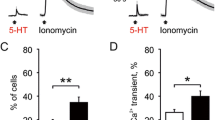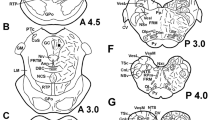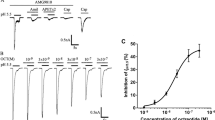Summary
We have examined the effects of salmon calcitonin (SCT), injected into the cerebral ventricle (i.c.v.), on the tail-biting and scratching behavior induced by the intrathecal injection of different types of nociceptive agents, i.e., substance P, N-methyl-D-aspartate (NMDA), kainate (KA), and quisqualate (Quis). Tail-biting and scratching behavior induced by the 4 substances was significantly inhibited by SCT (i.c.v.) in the same manner: the dose-response curves were U-shaped, and the most effective dose was O.lIU/mouse in all cases. SCT did not, however, completely inhibit tail-biting and scratching behavior. At its most effective dose, the percent inhibition of substance P-, NMDA-, KA- and Quis-induced behavior were 77.9%, 40.2%, 49.4%, and 52.9%, respectively. These results suggest that SCT has the inhibitory effects of substance P- and glutamate receptor agonists-induced nociceptive response in vivo.
Similar content being viewed by others
References
Aanonsen LM, Wilcox GL (1987) Nociceptive action of excitatory amino acids in the mouse: effects of spinally administered opioids, phencyclidine and sigma agonists. J Pharmacol Exp Ther 243: 9–19
Azria M (1989) The calcitonins: physiology and pharmacology. Karger, Basel
Berressem P, Dambacher MA, Schmidt G (1985) Kontrollierte Wirkungsprüfungen von Lachs-Calcitonin bei Patienten mit Knochenmetastasen. Therapiewoche 35: 992–995
Biasi SD, Rustioni A (1988) Glutamate and substance P coexist in primary afferent terminals in the superficial laminae of spinal cord. Proc Natl Acad Sci USA 85: 7820–7824
Braga P, Ferri S, Santagostino A, Olgiati VR, Pecile A (1978) Lack of opiate receptor involvement in centrally induced calcitonin analgesia. Life Sci 22: 971–978
Dalo NL, Larson AA (1990) Effects of urethane and ketamine on substance P- and excitatory amino acid-induced behavior in mice. Eur J Pharmacol 184: 173–177
Fischer JA, Tobler PH, Kaufmann M, Born W, Henke H, Cooper PE, Sagar SM, Martin JB (1981 a) Calcitonin: regional distribution of hormone and its binding sites in the human brain and pituitary. Proc Natl Acad Sci USA 78: 7801–7805
Fischer JA, Sagar SM, Mertin JB (1981 b) Characterization and regional distribution of calcitonin binding sites in the rat brain. Life Sci 29: 663–671
Franceschini R, Cataldi A, Barreca T, Salvemini M, Rolandi E (1989) Plasma beta-endorphin, ACTH and cortisol secretion in man after nasal spray administration of calcitonin. Eur J Clin Pharmacol 37: 341–343
Frenk H, Bossut D, Urca G, Mayer DJ (1988) Is substance P a primary afferent neurotransmitter for nociceptive input? I. Analysis of pain-related behaviors resulting from intrathecal administration of substance P and 6 excitatory compounds. Brain Res 455: 223–231
Goltzman D, Mitchell J (1985) Interaction of calcitonin and calcitonin gene-related peptide at receptor sites in target tissues. Science 227: 1343–1345
Guidobono F, Netti C, Pagani F, Sibilia V, Pecile A, Candeletti S, Ferri S (1986) Relationship of analgesia induced by centrally injected calcitonin to the CNS serotonergic system. Neuropeptide 8: 259–271
Haley TJ, McCormick WG (1957) Pharmacological effects produced by intracerebral injection of drugs in the conscious mouse. Br J Pharmacol 12: 12–15
Hindley AC, Hill EB, Leyland MJ, Wiles AE (1982) A double-blind controlled trial of salmon calcitonin in pain due to malignancy. Cancer Chemother Pharmacol 9: 71–74
Hornfeldt CS, Larson AA (1989) Selective inhibition of excitatory amino acids by divalent cations. A novel means for distinguishing N-methyl-D-aspartic acid-, kainate- and quisqualate-mediated actions in the mouse spinal cord. J Pharmacol Exp Ther 251: 1064–1068
Hylden JK, Wilcox G (1980) Intrathecal morphine in mice: a new technique. Eur J Pharmacol 67: 313–316
Hylden JK, Wilcox G (1981) Intrathecal substance P elicits a caudally-directed biting and scratching behavior in mice. Brain Res 217: 212–215
Jaeger H, Maier C (1992) Calcitonin in phantom limb pain: a double-blind study. Pain 48: 21–27
Jansen KLR, Faull RLM, Dragunow M, Waldvoge H (1990) Autoradiographic localisation of NMDA, quisqualate and kainic acid receptors in human spinal cord. Neurosci Lett 108: 53–57
Kangrga I, Randic M (1990) Tachykinins and calcitonin gene-related peptide enhance release of endogenous glutamate and aspartate from the rat spinal dorsal horn slice. J Neurosci 10: 2026–2038
Moochhala SM, Sawynok J (1984) Hyperalgesia produced by intrathecal substance P and related peptides: desensitization and cross desensitization. Br J Pharmacol 82: 381–388
Nabeshima T, Maeda Y, Yamada K, Nakamura T, Hasegawa T (1994) The inhibitory effects of salmon calcitonin on intrathecally-injected N-methyl-D-aspartate-induced aversive behavior in mice. Res Commun Chem Pathol Pharmacol (in press)
Nakamuta H, Furukawa S, Koida M (1981) Specific binding of125I-salmon calcitonin to rat brain: regional variation and calcitonin specificity. Jpn J Pharmacol 31: 53–60
Olgiati VR, Guidobono F, Netti C, Pecile A (1983) Localization of calcitonin binding sites in rat central nervous system: evidence of its neuroactivity. Brain Res 265: 209–215
Patti F, Scapagnini U, Nicoletti F, Prato A, Millia C, Clementi G (1986) Calcitonin and migraine. Headache 26: 172–174
Randic M, Hecimovic H, Ryu PD (1990) Substance P modulates glutamate-induced currents in acutely isolated rat spinal dorsal horn neurones. Neurosci Lett 117: 74–80
Rizzo AJ, Goltzman D (1981) Calcitonin receptors in the central nervous system of the rat. Endocrinology 108: 1672–1677
Rusin KI, Bleakman D, Chard PS, Randic M, Miller RJ (1993) Tachykinins potentiate N-methyl-D-aspartate responses in acutely isolated neurons from the dorsal horn. J Neurochem 60: 952–960
Sakurada T, Manome Y, Tan-No K, Sakurada S, Kisara K (1990) The effects of substance P analogues on the scratching, biting and licking response induced by intrathecal injection of N-methyl-D-aspartate in mice. Br J Pharmacol 101: 307–310
Spampinato S, Candeletti S, Cavicchini E, Romualdi P, Speroni E, Ferri S (1984) Antinociceptive activity of salmon calcitonin injected intrathecally in the rat. Neurosci Lett 45: 135–139
Üstdal M, Dogan P, Soyuer A, Terzi S (1989) Treatment of migraine with salmon calcitonin: effects on plasma β-endorphin, ACTH and cortisol levels. Biomed Pharmacother 43: 687–691
Watkins JC, Evans RH (1981) Excitatory amino acid transmitters. Ann Rev Pharmacol Toxicol 21: 165–204
Wiesenfeld-Hallin Z, Persson A (1984) Subarachnoid injection of salmon calcitonin does not induce analgesia in rats. Eur J Pharmacol 104: 375–377
Wilcox GL (1988) Pharmacological studies of grooming and scratching behavior elicited by spinal substance P and excitatory amino acids. Ann NY Acad Sci 525: 228–236
Author information
Authors and Affiliations
Rights and permissions
About this article
Cite this article
Maeda, Y., Yamada, K., Hasegawa, T. et al. Inhibitory effects of salmon calcitonin on the tail-biting and scratching behavior induced by substance P and three excitatory amino acids. J. Neural Transmission 96, 125–133 (1994). https://doi.org/10.1007/BF01277934
Received:
Accepted:
Issue Date:
DOI: https://doi.org/10.1007/BF01277934




